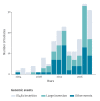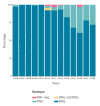Evolution of Bordetella pertussis over a 23-year period in France, 1996 to 2018
- PMID: 34533118
- PMCID: PMC8447829
- DOI: 10.2807/1560-7917.ES.2021.26.37.2001213
Evolution of Bordetella pertussis over a 23-year period in France, 1996 to 2018
Abstract
BackgroundBordetella pertussis is the main agent of whooping cough. Vaccination with acellular pertussis vaccines has been largely implemented in high-income countries. These vaccines contain 1 to 5 antigens: pertussis toxin (PT), filamentous haemagglutinin (FHA), pertactin (PRN) and/or fimbrial proteins (FIM2 and FIM3). Monitoring the emergence of B. pertussis isolates that might partially escape vaccine-induced immunity is an essential component of public health strategies to control whooping cough.AimWe aimed to investigate temporal trends of fimbriae serotypes and vaccine antigen-expression in B. pertussis over a 23-year period in France (1996-2018).MethodsIsolates (n = 2,280) were collected through hospital surveillance, capturing one third of hospitalised paediatric pertussis cases. We assayed PT, FHA and PRN production by Western blot (n = 1,428) and fimbriae production by serotyping (n = 1,058). Molecular events underlying antigen deficiency were investigated by genomic sequencing.ResultsThe proportion of PRN-deficient B. pertussis isolates has increased steadily from 0% (0/38) in 2003 to 48.4% (31/64) in 2018 (chi-squared test for trend, p < 0.0001), whereas only 5 PT-, 5 FHA- and 9 FIM-deficient isolates were found. Impairment of PRN production was predominantly due to IS481 insertion within the prn gene or a 22 kb genomic inversion involving the prn promoter sequence, indicative of convergent evolution. FIM2-expressing isolates have emerged since 2011 at the expense of FIM3.ConclusionsB. pertussis is evolving through the rapid increase of PRN-deficient isolates and a recent shift from FIM3 to FIM2 expression. Excluding PRN, the loss of vaccine antigen expression by circulating B. pertussis isolates is epidemiologically insignificant.
Keywords: Bordetella pertussis; fimbriae serotype; pertactin; population evolution; vaccine antigen deficiency.
Conflict of interest statement
Figures




References
-
- Locht C. Molecular aspects of Bordetella pertussis pathogenesis. Int Microbiol. 1999;2(3):137-44. - PubMed
MeSH terms
Substances
LinkOut - more resources
Full Text Sources
Medical
